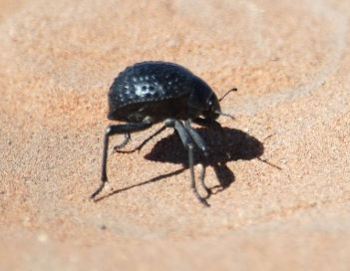Jan 25 2016
A group of researchers, led by Virginia Tech, have used chemical micropatterns to control the spread of frost caused by condensation. This discovery will help prevent frost on windshields, condenser coils, and airplane parts.
 The Namib Desert Beetle lives in one of the hottest places in the world, yet it still collects airborne water. Taking a page from the beetle's playbook, Virginia Tech biomedical engineers created a way to control condensation and frost growth. Credit: Wikimedia Commons
The Namib Desert Beetle lives in one of the hottest places in the world, yet it still collects airborne water. Taking a page from the beetle's playbook, Virginia Tech biomedical engineers created a way to control condensation and frost growth. Credit: Wikimedia Commons
In the 'Writing in Scientific Reports' journal, the researchers explain how growth of frost can be prevented or controlled with the use of photolithography to design chemical arrays that attract water over a surface that repels water.
The research was inspired by the Namib Desert Beetle, which survives in one of the world’s hottest places, yet it is able to collect airborne water.
The beetle has a bumpy shell and the tips of the bumps attract moisture in order to produce drops. The sides of the insect are smooth and repel water, developing channels that lead directly to its mouth.
I appreciate the irony of how an insect that lives in a hot, dry desert inspired us to make a discovery about frost. The main takeaway from the Desert Beetle is we can control where dew drops grow.
Jonathan Boreyko, Assistant Professor of Biomedical Engineering and Mechanics, Virginia Tech College of Engineering
The researchers, working at the Oak Ridge National Laboratory, created their frost-controlling chemical pattern on a surface measuring a centimeter, but they believe that it is possible to scale up the area with thirsty, hydrophilic patterns on top of a water-repellant or hydrophobic surface.
We made a single dry zone around a piece of ice. Dew drops preferentially grow on the array of hydrophilic dots. When the dots are spaced far enough apart and one of the drops freezes into ice, the ice is no longer able to spread frost to the neighboring drops because they are too far away. Instead, the drops actually evaporate completely, creating a dry zone around the ice.
Jonathan Boreyko, Assistant Professor of Biomedical Engineering and Mechanics, Virginia Tech College of Engineering
The formation of frost-free zones on bigger surface may lead to a wide range of applications - consider the water that is produced and then frozen on heat pump coils, or the deicing with strong chemicals that occur on airplane wings or wind turbines.
Keeping things dry requires huge energy expenditures. That’s why we are paying more attention to ways to control water condensation and freezing. It could result in huge cost savings.
C. Patrick Collier, Research Scientist, Nanofabrication Research Laboratory Center for Nanophase Materials Sciences, Oak Ridge National Laboratory
The researchers stated that the journey of frost over a surface starts with a single dew drop that is frozen.
“The twist is how ice bridges grow,” Boreyko said. “Ice harvests water from dew drops and this causes ice bridges to propagate frost across the droplets on the surface. Only a single droplet has to freeze to get this chain reaction started.”
The team succeeded in completely preventing or controlling the growth rate of frost by monitoring the spacing of the condensation process.
Fluids go from high pressure to low pressure. Ice serves as a humidity sink because the vapor pressure of ice is lower than the vapor pressure of water. The pressure difference causes ice to grow, but designed properly with this beetle-inspired pattern, this same effect creates a dry zone rather than frost.
Jonathan Boreyko, Assistant Professor of Biomedical Engineering and Mechanics, Virginia Tech College of Engineering
The research was partially carried out at the Center for Nanophase Materials Sciences, which is a Department of Engineering Office of Science user facility. Startup support was provided by the Department of Biomedical Engineering and Mechanics at Virginia Tech.